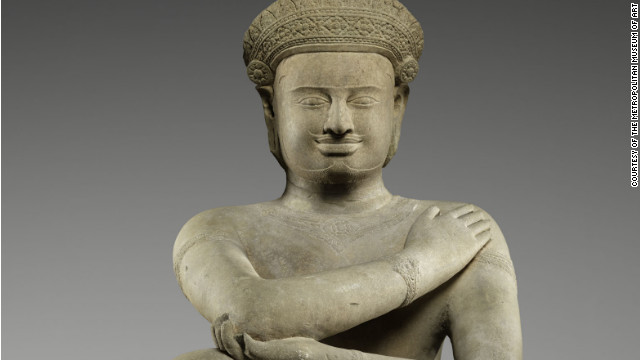June 7, 2012 -- Updated 1757 GMT (0157 HKT)

This kneeling figure at the Metropolitan Museum of Art was estimated to have been carved around 921 to 945.
Editor's note: Mark V.
Vlasic, a senior fellow and adjunct professor of law at Georgetown
University, served as the first head of operations of the joint United
Nations-World Bank Stolen Asset Recovery Initiative and leads the international practice at Madison Law & Strategy Group PLLC. Tess Davis is the executive director of the Lawyers' Committee for Cultural Heritage Preservation and is working with Cambodia to combat the illicit trade in the kingdom's antiquities.
(CNN) -- The last time most New Yorkers focused on
pillaged antiquities from Cambodia was likely after the release of the
Angelina Jolie film "Lara Croft: Tomb Raider," which featured the
heroine's adventures through the country's famous archaeological wonder,
Angkor Wat.
Now, real "tomb raiding"
is making the news as the Cambodian government seeks to recover
antiquities allegedly plundered from the kingdom's ancient sites during
its civil war, ethnic cleansing and foreign occupation.
At Cambodia's request, the United States recently filed suit in U.S. District Court against Sotheby's in New York, demanding that the auction house forfeit a sandstone warrior that was "illicitly removed," according to the complaint, from a remote jungle temple. But according to a recent New York Times story,
Cambodia has now set its sights on another Manhattan institution: the
Metropolitan Museum of Art. It has specifically targeted the highlight
of its Southeast Asian collection: two kneeling figures that
archaeologists declare are companions to the contested Sotheby's piece.
If these stones could speak, what a story they would tell.
Carved in the 10th
century by some of the most skilled artisans known to history, they
originally adorned the sanctuary of Prasat Chen, at the temple complex
of Koh Ker. Experts believe that with other characters, they formed a
three dimensional tableau from the Hindu epic the Mahabharata for a
millennium. They say that came to an end when paramilitary groups
trafficked them, sculpture by sculpture, overseas.
What a strange twist of
fate: Having traveled halfway around the world, quite possibly through
the illicit and licit markets, the three disputed objects are now just
miles apart in New York City.
Phnom Penh's forceful
request for their return has alarmed the less scrupulous in the art
world, and with good reason: They have a lot to lose if the art is
repatriated. American and European galleries, auction houses and museums
are allegedly full of Cambodian plunder. Many of these artifacts were
allegedely stolen during the country's long conflict, making them "blood
antiquities," little different than "blood diamonds" from Sierra Leone and other war-torn African states.
The years before, during,
and after the Killing Fields decimated the Cambodian population and led
to the looting of most of the nation's archaeological sites. Yet sadly,
now that Cambodia is at peace and in a position to recover its rightful
property, some collectors are portraying themselves as the victims.
In the wake of the Sotheby's case, one Asian specialist lamented the "crisis" now facing collectors. She warned that such legal actions
"threaten the very future of collecting and collecting museums" and the
"next generation of collectors, donors and patrons." Such histrionics
aside, it will always be difficult and expensive for countries such as
Cambodia to recover their pillaged heritage through the courts, even
when in the right.
Especially when its
acquisition may have been made possible by tragedies such as the
Holocaust, Cambodia's killing fields or even the more recent looting of
the Baghdad Museum during the Iraq war, the real issue is why any
collector or museum would want to possess stolen art?
Thankfully, individuals
and institutions who would argue to keep looted art are a minority and
do as much disservice to their fellows as they do to victims of the
illicit art trade. Indeed, many have voluntarily repatriated antiquities
to Cambodia, once learning they were wartime plunder. The Met is no
exception, having itself returned a valuable piece to the country in 1997 at its own initiative.
There is much common
ground between archaeologists, collectors and curators, as all share a
love of the past, if not an outright obsession with it. Archaeologists
recognize that there will always be, and should be, a legal market for
antiquities, just as most collectors and curators agree that the looting
of archaeological sites and trafficking of antiquities must be stopped.
Indeed, if there is to
be any real progress, both sides of the issue will likley have to make
concessions. But as campaigns like Cambodia's demonstrate, the art world
must reconsider what is ethically acceptable. And today, the sale,
purchase and exhibition of "blood antiquities" is not only deplorable, it may actually be criminal. (The sale, possession, and transport of stolen property is illegal under the National Stolen Property Act.)
Sotheby's and the Met
have a choice: They can treat Cambodia's requests as obstacles, or
recognize them as the opportunities they are to right past wrongs and
set the moral standard for the entire field. For Cambodia's sake, as
well as their own -- and for all of humanity that finds these treasures
important -- let us hope that they choose wisely.

2 comments:
The face of statue is not Khmer face.
Are you racially profiling? What qualifie you to judge what Khmer 's face should look?
Post a Comment